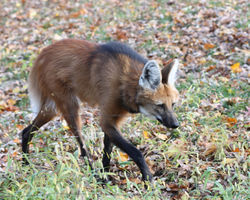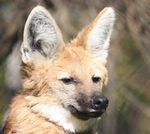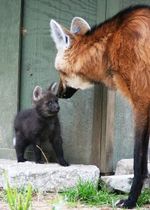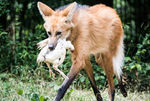Maned wolf
| Maned wolf |
|---|

|
| Scientific Classification |
|
| Scientific Name |
|
Chrysocyon brachyurus |
The Maned wolf is species of Canid known by the scientific name Chrysocyon brachyurus . It is distinguished by its reddish brown fur and noticeably long dark legs. They are found in South American tall grasslands and scrub forests in Brazil, Paraguay, Bolivia, Argentina, and Uruguay. They are nocturnal predators, hunting primarily at night, but with an omnivorous diet that also includes fruit, sugarcane and other plants.
Body Design
The Maned wolf is covered in reddish-brown fur. [1] It has long, slender legs and pointed muzzles, both black in color. [2] Maned wolves have white chins, throats, ears, and tail tips. Along their back is a strip of fur (the "mane") that can stand upright when they sense danger. [3] Maned wolves are very large, measuring 42 inches (107 centimeters) tall, and weighing 75 pounds (34 kilograms). Despite being so large, they are timid and quite skittish. [4]
Life Cycle
Maned wolves are monogamous, meaning they only have one mate.[5] Breeding season is between August and October. After a 65 day gestation period, the pups are born. At birth, the pups weigh 12-15 ounces (340-430 grams) and are dark grey in color (see picture at left). They change color as they grow, turning red by 10 weeks and by 15 weeks, they are weaned. The Maned wolf pups leave their parents after one year, when they become sexually mature. [6]
Ecology
Maned wolves are found in tall grasslands and scrub forests of South America. Their range extends across Brazil, Paraguay, Bolivia, Argentina, and a small area in Uruguay.[6] In tall grasslands, it is hot and humid. Few trees can survive because of undeveloped, deep soil, but hardy grasses thrive there. The temperature can get to -40 degrees Fahrenheit in the winter and 70 degrees Fahrenheit in the summer. Rainfall averages at 25-60 inches per year. This biome's year is divided into two seasons: a dormant season when nothing can grow because of the frost and a growing season when the temperature is high and grasses can grow.[7]
Maned wolves are omnivorous and eat a variety of food. They eat small rodents such as cuis(wild guinea pigs), young viscachas, pacas, and agoutis. They also consume other meats: birds, reptiles, insects, and other invertebrates. A large portion of their diet includes plant matter such as fruits and sugarcane. [1]
Maned wolves are at the top of the food chain, and have no predators other than humans. Humans kill Maned wolves to protect their livestock or just for sport. The Maned wolf's habitat is being destroyed so it can be used for agriculture. Humans restrict their numbers, making the species threatened.[8]
Misnomer
The common name of Chrysocyon brachyurus, the Maned wolf, is a very misleading misnomer. First, the "mane" is just a strip of black fur on the Maned Wolf's back that can stand upright when startled. The fur of the "mane" is not even longer than the rest of its body. Secondly, the Maned wolf is not a wolf at all in three aspects. While it is a Canid, it is not in the same genus as wolves. It is classified as closer to the bush dog. Also, most say it resembles a fox more than a wolf because of its reddish-brown coloration. Lastly, the Maned wolf is a highly solitary creature that only interacts with others of its species during mating season to breed. Typically, wolves are social and form packs and work together to hunt.
Unfortunately, like many other organisms, the Maned wolf has been called a very inaccurate misnomer, resulting in much confusion when using its common name.
Video
The Maned wolf has a rarely heard call, nicknamed the roar bark, that males use to communicate.
References
- ↑ 1.0 1.1 Maned Wolf World Wildlife Fund For Nature. Accessed 9 January 2017. Unknown Author.
- ↑ Maned Wolf Endangered Wolf Center. Accessed January 16, 2017. Unknown Author.
- ↑ Maned wolf (Chrysocyon brachyurus) Arkive. Authenticated September 15, 2008. Unknown Author.
- ↑ Maned Wolf - Long Legs With Red Fox Head FactZoo. Accessed January 17, 2017. Unknown Author.
- ↑ Reproduction In the Maned Wolf The Maned Wolf Resource. Accessed 18 January, 2017. Unknown Author.
- ↑ 6.0 6.1 Melanie Hanson. Chrysocyon brachyurus - Maned Wolf University of Wisconsin Steven's Point. Last updated March 29, 2005.
- ↑ M., Sam. Grasslands Blue Planet Biomes. Published 2000.
- ↑ Maned Wolf White Oak Wildlife. Accessed 18 January, 2017. Unknown Author.



